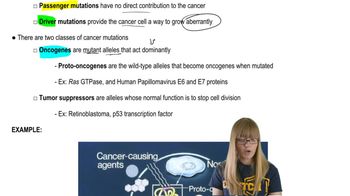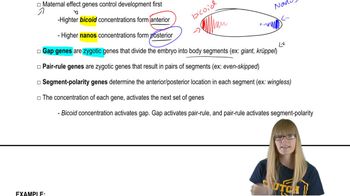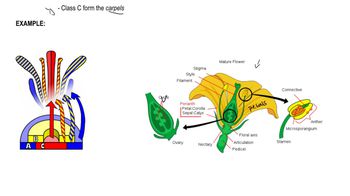Table of contents
- 1. Introduction to Genetics51m
- 2. Mendel's Laws of Inheritance3h 37m
- 3. Extensions to Mendelian Inheritance2h 41m
- 4. Genetic Mapping and Linkage2h 28m
- 5. Genetics of Bacteria and Viruses1h 21m
- 6. Chromosomal Variation1h 48m
- 7. DNA and Chromosome Structure56m
- 8. DNA Replication1h 10m
- 9. Mitosis and Meiosis1h 34m
- 10. Transcription1h 0m
- 11. Translation58m
- 12. Gene Regulation in Prokaryotes1h 19m
- 13. Gene Regulation in Eukaryotes44m
- 14. Genetic Control of Development44m
- 15. Genomes and Genomics1h 50m
- 16. Transposable Elements47m
- 17. Mutation, Repair, and Recombination1h 6m
- 18. Molecular Genetic Tools19m
- 19. Cancer Genetics29m
- 20. Quantitative Genetics1h 26m
- 21. Population Genetics50m
- 22. Evolutionary Genetics29m
14. Genetic Control of Development
Developmental Patterning Genes
Problem 7b
Textbook Question
What is the phenotype associated with zygotic gene mutations?
 Verified step by step guidance
Verified step by step guidance1
Understand that zygotic gene mutations refer to mutations that occur in the genes of the zygote, which is the initial cell formed when two gametes (sperm and egg) are joined.
Recognize that the phenotype is the observable physical or biochemical characteristics of an organism, as determined by both genetic makeup and environmental influences.
Consider that zygotic gene mutations can lead to a variety of phenotypic outcomes, depending on the specific genes affected and the nature of the mutation (e.g., loss of function, gain of function, etc.).
Identify that the phenotype associated with a zygotic gene mutation can range from no observable effect to significant developmental abnormalities or diseases, depending on the role of the mutated gene in development and physiology.
Explore examples of phenotypes resulting from zygotic gene mutations, such as developmental disorders or congenital anomalies, to better understand the potential impacts of these mutations.
Recommended similar problem, with video answer:
 Verified Solution
Verified SolutionThis video solution was recommended by our tutors as helpful for the problem above
Video duration:
3mPlay a video:
Was this helpful?
Key Concepts
Here are the essential concepts you must grasp in order to answer the question correctly.
Phenotype
Phenotype refers to the observable physical and physiological traits of an organism, which result from the interaction of its genotype with the environment. It includes characteristics such as morphology, development, biochemical properties, and behavior. Understanding phenotype is crucial for studying how genetic mutations manifest in an organism.
Recommended video:
Guided course

Mutations and Phenotypes
Zygotic Gene Mutations
Zygotic gene mutations occur in the zygote, the fertilized egg formed by the union of sperm and egg. These mutations can affect the development of the organism from the earliest stages, potentially leading to various phenotypic outcomes. The timing and nature of these mutations can significantly influence the resulting phenotype.
Recommended video:
Guided course

Cancer Mutations
Genotype-Phenotype Relationship
The genotype-phenotype relationship describes how the genetic makeup (genotype) of an organism influences its observable traits (phenotype). This relationship is complex, as multiple genes can interact to produce a single trait, and environmental factors can also play a significant role. Understanding this relationship is essential for predicting the effects of zygotic gene mutations on phenotype.
Recommended video:
Guided course

Gamete Genotypes

 11:19m
11:19mWatch next
Master Segmentation Genes with a bite sized video explanation from Kylia Goodner
Start learningRelated Videos
Related Practice



